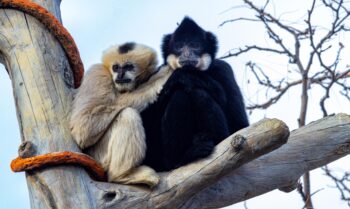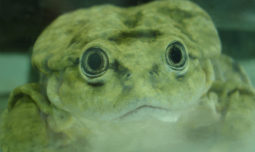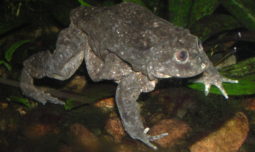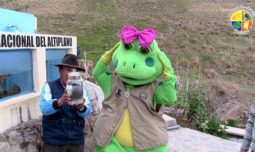March 19, 2019
Celebrating World Frog Day
Take a Moment to Remember That Tiny-But-Mighty Frogs Need Our Help
By Natalie Ingle
Frogs don’t make a lot of headlines. They’re not especially charismatic, and they don’t seem to capture the public’s imagination like elephants, rhinos or tigers—animals whose conservation plights and efforts to save them are well known around the world.
But take one look at a Lake Titicaca frog (LTF), and you might change your mind. Thanks to their forward-facing eyes and a mouth that seems stuck in a perpetual lazy smile, there’s something distinctly human-like about their faces. LTFs also happen to be the top native predator in their namesake lake and are considered the world’s largest entirely aquatic frog, once measuring up to 20 inches from toe to toe in the days of Jacques Cousteau.
They’re smaller these days, a little harder to find and are now classified by the International Union for Conservation of Nature as critically endangered. Over the past decade since Denver Zoo began studying the species in Peru, periodic die-offs, which kill thousands of frogs at once, have been occurring with growing frequency and intensity, with mining runoff and untreated sewage as the suspected culprits. The frogs are also harvested for use in homeopathic “smoothie” recipes that promise virility, cures from diseases and a variety of other unproven health benefits. To make matters worse, just a few years ago, Denver Zoo’s researchers published the first documentation that chytrid fungus, which is blamed for drastic declines in amphibians worldwide, was present on the Peruvian side of the lake.
So how could a zoo hope to combat such lopsided threats? By leveraging our expertise in five core areas: 1) community engagement & conservation education, 2) building the capacity of local organizations, 3) improving protected area management, 4) influencing policy and 5) utilizing our skills in exhibit design and captive breeding.
World Frog Day may be new to most Americans, but Peruvians have been enjoying their own Frog Day for years. In partnership with Lima-based Huachipa Zoo and Titicaca National Reserve, we helped launch this beloved event in 2010 to raise awareness about the LTF and its plight. With a person-sized LTF mascot, hands-on activities, and frog-themed celebrations, these events in Lima and Puno are designed to dispel popular myths, increase pride in the frog as a unique national treasure and empower participants to help save it. Ccori Ampara, a women’s collective that we helped establish, also leverages local pride in the LTF by creating frog-festooned handicrafts made with Peru’s famous alpaca wool.
Meanwhile, we’ve worked closely with reserve management to better understand what conditions the frog needs to survive. This first required our Peru Program Director, Roberto Elias, to coach rangers in snorkeling and conducting aquatic surveys. We also partnered with a Colorado high school where students developed a remotely operated vehicle (ROV) to support underwater research. In 2010, we co-facilitated the first ever stakeholder workshop to develop a conservation strategy for LTFs.
Eventually, these efforts began to generate regional and even international attention (see articles in The Guardian, National Geographic, and Wired, among others). People started to realize that some of what was killing the frogs might be making its way into the water they used for drinking or growing crops. The Peruvian government took notice, too. In 2012, it declared the Lake Titicaca frog a species of conservation interest, elevating LTFs to the highest priority in the Lake Titicaca region.
Visitors to Denver Zoo’s Tropical Discovery exhibit may have noticed that we’ve also had great success with captive breeding of LTFs. We were the first zoo in the northern hemisphere to do so and have since shared more than one hundred frogs with other zoos and aquaria. In Peru, we helped Huachipa Zoo get their own LTF exhibit up and running, complete with interpretative signage and educational programs to celebrate the frog.
With all of these tried and tested strategies in-hand, we’re now turning our attention to one of the LTF’s closest relatives—the endangered Lake Junin frog. Its habitat sits at over 13,000 feet in elevation, but the threats to its survival are largely the same.
We were recently awarded a prestigious National Geographic Society grant to ramp up our efforts in Junin. Our first steps will be answering key questions about the frog itself, what environmental factors it requires to thrive (and which factors may be leading to its decline) and whether it’s struggling with chytrid or other diseases.
We’ll also work with local communities to begin monitoring and caring for smaller bodies of water, including canals and streams that feed into the lake. Volunteer leaders from those communities will help design strategies to cut down on herbicide runoff, minimize disturbances and reduce frog harvest, while encouraging neighbors to report sightings of the frog. Through the process, they’ll learn that what’s good for the frog is good for people, the first step in raising concern for the health of the lake—which also happens to be the headwaters of a tributary into the Amazon.
And just like we did with the LTF, we’ll advocate for the government to recognize the Junin frog as a species of “conservation interest.” Such a move would increase the likelihood that officials would direct public funding to support our collective efforts.
Huachipa Zoo is also preparing to gather a few wild Junin frogs to start an assurance population, an important step in ensuring the species persists even if it becomes extinct in the wild. If threats can eventually be brought under control, these animals could help re-establish a wild population. Once permits are lined up, our Peru Program Director will help guide the expedition to find and collect the frogs.
In the meantime, Denver Zoo, Huachipa Zoo, and another local partner, Grupo RANA, are already planning outreach efforts to give Peruvians even more to be proud of. On this World Frog Day, we hope you’ll share a greater appreciation for our tiny-but-mighty amphibians, too.
Learn more about our work conserving LFTs and Junin giant frogs in Peru and what you can do to help.
Photos by Denver Zoo staff and Andrew Watson
Subscribe
Be among the first to hear the latest animal updates, important stories and details about all the fun happening around Denver Zoo.
Tags
-
 April 15, 2024
April 15, 2024Good Luck, Chuck!
Good Luck, Chuck! Beloved Bachelor Relocating as Part of Asian Elephant Species Survival Plan In a heartfelt and collaborative…
-
 April 15, 2024
April 15, 2024African Impact
African Impact Two New African Field Conservation ProgramsAim to Protect Gorillas + Grey Crowned Cranes We're honored to provide…
-
 March 1, 2024
March 1, 2024Last Place(s) on Earth
Last Place(s) on Earth New Asian Field Conservation Programs Protect Asian Elephants, Sumatran Orangutans + more Indonesia's Leuser Ecosystem…





